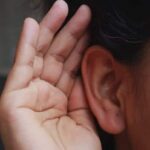Therapeutic Listening explained: the definition and theory

Therapeutic Listening: this article explains Therapeutic Listening in a practical way. Next to what it is (definition), this article also highlights the skills, the tips, the negative aspects that prevent effective listening and the importance of verbal and non-verbal communication, the benefits Benefits of theurapeutic listening, closing with a short summary. Enjoy reading!
Introduction
Cognitive learning is important for the development of different types of aspects of communication, such as language, writing and listening. These are important factors for the processing of information and as a result achieving knowledge. This article will focus on the auditory process and the importance of Therapeutic Listening for the benefit of the human being.
Before delving into the method of Therapeutic Listening, some essential questions must be answered. What is listening? How is cognitive learning connected to listening? Which communication skills can be developed?
What is listening?
Listening is the process of listening to sounds in both a conscious and unconscious way. It is also about being able to organize the sounds in association with our mental attention in order to collect information.
This process is part of the sensory system which is part of the nervous system and in which, apart from hearing, sight, smell, touch and taste are also involved. It should be noted that the auditory system tracks sounds by means of sound waves that are in space.
By separating this auditory sensory system from the theoretical explanation, it is necessary to transcend the importance of listening and mark the differences that this term brings.
Listening is something that goes beyond a physical or a biological process. It is the attention to the processing of information that is linked to emotions and thought.
What is Therapeutic Listening? The theory
The definition of Therapeutic Listening
Therapeutic listening is the process of gathering information and exchanging communication from a therapeutic setting. Emotions are vital to the processing and sharing of information in this setting. It is also a method for improving verbal and non-verbal understanding of communication.
Some people define therapeutic listening as a sound based intervention method, designed to help people who experience difficulties in the processing of sensory information or regulating energy levels.
As this is an evidence based protocol, the method is used in the health sector for the treatment of patients. It helps in their development of confidence, sensory experience, interpersonal, social and cognitive skills in the behaviour of people.
Trust and empathy are pillars in this therapeutic concept of listening. Being careful and honest with the listening is vital for the other person to be able to express themselves freely. It is also crucial to understand their thoughts and emotions that go beyond words. People tend to fall into one of these categories: non-listener, marginal listener, evaluative listener and active listener.
The following skills can be further developed with Therapeutic Listening:
Active Listening
This is the highest level of listening as there is efficient communication involved. In this category the person is listened to carefully and is not interrupted while the person is expressing himself. The active listener asks questions and also uses body gestures to help understand the speaker.
In active listening, non-verbal expressions are also part of efficient communication. Good posture and visual connection allows the speaker to feel confident in expressing themselves.
Attention and silence are key factors in this category. A good listening attitude, the ability to listen and the opportunity for conversation and feedback makes this category efficient.
Reflective Listening
Reflective listening is common among professionals who offer psychological or medical help. In this category, the story the speaker is telling is not modified as it is necessary to know the speaker’s version. Be attentive in all your speech. Most of the times the speaker is going through a difficult situation in his life.
Comprehensive listening
At this level, the listener has the ability to process everything the speaker says in a fast and clear way.
These three levels go hand in hand in a conversation. Each level can have its own level of depth according to the moment it is needed. Also, listening skills are gradually emerging.
Tips when you want to practice Therapeutic Listening
1. Non-verbal participation
Pay attention to the speaker. Focus on what that person is saying. Offering words or gestures that reinforce listening can connect the speaker and make them understand that attention is complete on them.
2. Focus on the message
It is important to focus on the emotions, voice and posture that the speaker reflects when telling his or her story. Non-verbal language can help to live the message much more intensely, by trying to be in the other’s shoes.
3. Do not judge
Do not give an opinion or comment on everything the speaker says. It is important to collect the information and if it is important to share feedback what the person said.
4. Tolerate silence
It is important to know how to tolerate silence in a conversation. Silence does not mean disinterest in the subject being discussed. It can more easily help to be in concentration with what the speaker is saying and lead to understanding and reflection.
5. Paraphrasing
Repeat the last words of the speaker or repeat key words so that the message is being understood. This will boost the participants confidence in the conversation.
5. Leave selfishness behind
When it comes to interupting a conversation, it is advisable to do so in the most empathetic and respectful way possible.
Therapeutic listening: negative aspects that prevent effective listening
There are certain negative aspects that prevent efficient listening. These should be kept in mind in order to overcome and not fall into error when having a conversation:
- Divided attention, doing several things at once when you are listening to someone
- Attention to ourselves, committing yourself to listening to the other person
- Not having time to listen: to the other person and going in a hurry
- Pretending to listen
- To play down what someone else says, because they disagree
Verbal and non-verbal communication as a complement to listening
Verbal communication
- It is important to be able to get feedback from the listener.
- Using a good tone of voice this can be a quiet tone with an acceptable volume.
- Ask open-ended, non-judgmental questions.
Non-verbal communication
- Visual contact
- Showing interest with facial and body gestures
- Show awareness and sensitivity to the emotions expressed by the speaker
- Silence to encourage the speaker to express himself without interruption
Listening is an essential communicative factor for good relationships. Psychological accompaniment, and even for professional and personal life, it is important to address oth.er factors of Listening as Therapy.
Therapeutic listening based on sound
Hate has an important role in the nervous system. This is why sensory integration in Therapeutic Listening is often used with children for their behaviour and learning and cognitive development. An occupational therapist creates a music selection which is based on the child’s goals and
Listening Therapy is based on electronic music to improve sensory processing, attention and communication skills in infants. Sound waves are passed to the neural pathways to improve self regulation in children.
These sensory studies have shown that children respond positively to these processes. Listening Therapy is used in children with autistic disorders, with attention deficit, hyperactivity, among others. Music is used as therapy for the development of communication skills in different stages of learning, anxiety reduction, improvement of personal skills, social behaviour, personal care and body management.
Benefits of Theurapeutic Listening
Therapeutic Listening can help both children and adults on issues such as:
- Focus and attention
- Orderly behaviour
- Social and communication skills
- Sensory behaviour
- Posture control
- Motor skills
- Sleep and nutrition patterns
- Positive response to sounds and verbal instructions
This practice aims to promote attention and calm in the brain in situations of stress.
Therapeutic Listening can be done in 30 minute, daily sessions. However, the frequency depends on what the person needs.
Therapeutic Listening, the summary
Listening goes beyond the biological process that human beings have. It is possible to hear while being present in the same space as an interlocutor. However, it is necessary to be focused on the gestures and the message that this person is broadcasting.
We must also remember that listening is one of the most basic and important forms of communication that exists. Without good listening conflict resolution, strategy planning, personal and social life would not be in balance.
Therapeutic Listening is a great way to put listening into practice and to develop skills. For children, this method is a good option for breaking down interpersonal and social barriers at the child’s stage of development. Apart from the use of healthy supportive conversation, music and sounds can also be used as a form of therapeutic listening.
It’s your turn
What do you think? Does Therapeutic Listening go beyond a conversation between one or more people? Have you put this method into your daily life to improve communication skills? Did you know that Therapeutic Listening can also be based on music?
Do you have anything else to add or any suggestions you would like to share?
Share your experience and knowledge in the comments box below.
More information
- Wolvin, A. D., & Coakley, C. G. (1985). Listening. Wm. C. Brown Publishers, 2460 Kerper Blvd., Dubuque, IA 52001.
- Kemper, B. J. (1992). Therapeutic listening: developing the concept. Journal of psychosocial nursing and mental health services, 30(7), 21-23.
- Watanuki, S., Tracy, M. F., & Lindquist, R. (2006). Therapeutic listening. Complementary / Alternative Therapies in Nursing, 45-56.
- Lee, B., & Prior, S. (2013). Developing therapeutic listening. British Journal of Guidance & Counselling, 41(2), 91-104.
How to cite this article:
Ospina Avendano, D. (2020). Therapeutic Listening. Retrieved [insert date] from Toolshero: https://www.toolshero.com/communication-methods/therapeutic-listening/
Published on: 09/12/2020 | Last update: 03/05/2023
Add a link to this page on your website:
<a href=”https://www.toolshero.com/communication-methods/therapeutic-listening/”>Toolshero: Therapeutic Listening</a>












